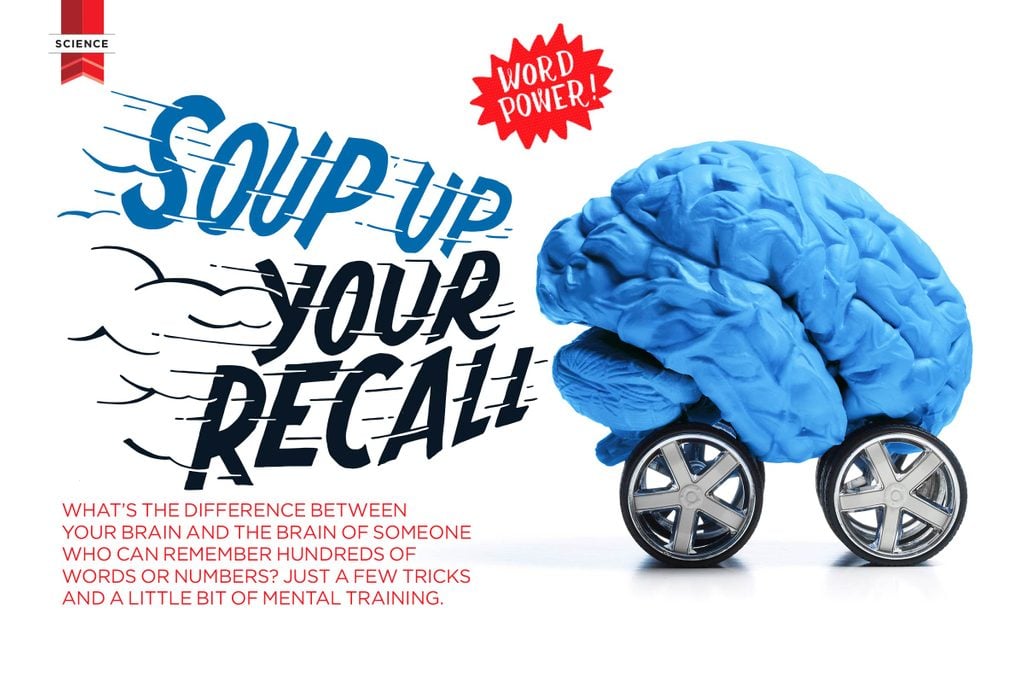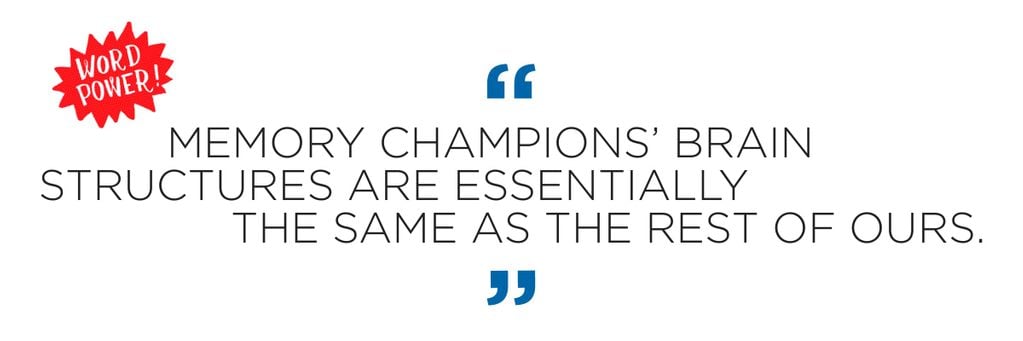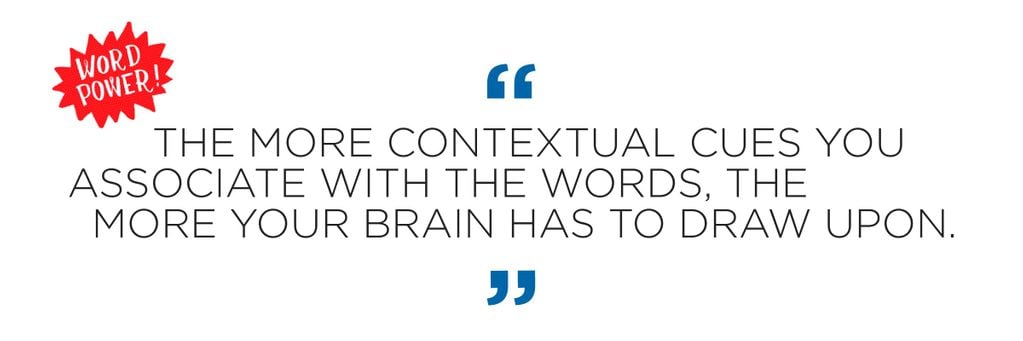You Can Train Your Brain to Have Superhuman Memory
Updated: Apr. 09, 2019
What’s the difference between your brain and the brain of someone who can remember hundreds of words OR numbers? Just a few tricks and a little bit of mental training.

In an age when your refrigerator can help you manage your shopping list and your phone can answer almost any question, you don’t really need to remember anything anymore. Which makes the feats of memory champions—who can recall hundreds of names and faces, random strings of numbers or words, or the order of multiple decks of cards—seem more superhuman than ever. (These are everyday habits of people with impressive memory.)
But here’s a nifty little secret about folks with phenomenal recall: In a study recently published in the journal Neuron, researchers found that super memorizers don’t have unusually large cerebral regions that allow them to absorb and retain prodigious amounts of information. Their brain structures are essentially the same as the rest of ours. Comparing brain scans of 23 memory champions (who had placed in the top 50 at the World Memory Championship) with those of 23 regular folks of the same age, gender, and IQ, the scientists found only one difference: In the memory champs’ brains, the regions associated with visual and spatial learning and the regions associated with memory lit up in a specific pattern. In the regular people’s brains, these regions were activated differently.
Why is that important? Because we learn by seeing, and the more we see, the better we remember things. These super memorizers have perfected a method to convert items they want to remember (numbers, faces, cards, even abstract shapes) into pictures they “see” in their minds. It’s a process called building a memory palace.

Here’s how it works: First, you transform your target items into an image—anything you’ll remember. For instance, to remember card sequences, Ed Cooke (recognized as a Grandmaster of Memory by the World Memory Sports Council) told author Tim Ferriss that he assigns each card a celebrity, an action, and an object; each three-card combination then forms a unique image with the celeb from the first card, the action from the second, and the object from the third. So “jack of spades, six of spades, ace of diamonds” becomes the Dalai Lama wearing Lady Gaga’s meat dress and holding Michael Jordan’s basketball.
(Yes, that sounds weird, but Cooke’s esoteric system is built on the idea that your memory hangs on to unusual cues better than mundane ones.)
Then, mentally place that picture somewhere familiar to you: in your house or at some point along your commute, for instance. Finally, make up a story about the items, which will help you connect them in the correct order. (Keep misplacing objects? Your memory problem could be something other than Alzheimer’s.)
Journalist Joshua Foer used the memory-palace technique to become a USA Memory Champion, an experience he chronicled in his book Moonwalking with Einstein. As he demonstrates in an online video, to memorize the first 100 digits of pi, he translates the numerals “141” to “DRD,” or “druid”; “592” to “LBN,” or “Libyan”; “653” to “ShLM,” or “shalom.” (To do this, he used the Major System, a mnemonic device that assigns each number a consonant sound, but you can use any system that makes sense to you.) Next, he imagines a druid sitting on the front lawn of his childhood home. He walks through the door to see Libyan leader Mu’ammar Gaddhafi sitting on the couch next to a dwarf shouting “Shalom!”
Sound like a lot of work? Indeed, it is. It’s no accident that many of the competitors on the World Memory Championship circuit call themselves mental athletes. Just like athletes, they train to hone their skills. That said, the Neuron study also reports that researchers taught a group of university students the memory-palace technique via daily half-hour lessons. After just six weeks, the students’ brain scans looked more like those of the memory champions. (This is how science can make your memories live forever.)
But you don’t have to train like an Olympian to improve your memory. Here are a few of our favorite tricks that can help in your everyday life.
Memory Target: Your PIN
Technique: Count it out
You could use your birthday, of course, or your phone number, but identity thieves have a way of ferreting those out. Instead, try this tip from Dominic O’Brien, an eight-time World Memory Champion. Write a four-word sentence, then count the number of letters in each word. For instance, “This is my PIN” = 4223.
Target: New vocabulary words
Technique: Switch up your study routine
In a classic study conducted at the University of Michigan in the 1970s, a group of students studied a list of words in two separate sessions. Some studied in a small cluttered room and some in a space with two windows and a one-way mirror. One group of studiers spent both sessions in the same room, while the other split the sessions between the two environments. During a test given in a completely different room, the students who studied in multiple places recalled 53 percent more than those who studied in just one room. Subsequent studies showed that varying other aspects of your environment (the time of day, the music in the background, whether you sit or stand, etc.) can also help recall. The theory is that your brain links the words (or whatever you are learning) to the context around you, and the more contextual cues you associate with the words, the more your brain has to draw upon when it’s trying to remember them.
Target: Facts and figures
Technique: Space out your study sessions
Mom was right: Cramming is not the best way to memorize things. To learn and recall statistics (or foreign vocabulary, historical dates, scientific definitions, lines for a play—pretty much any kind of factual information), reviewing the material periodically over a longer span of time is far more effective than repeating it in a shorter one. This technique dates as far back as 1885, when psychologist Hermann Ebbinghaus discovered that he could learn a list of nonsense words if he repeated them 68 times in one day and seven more times before being tested the next day. But he could learn the same number of words equally well by repeating them a total of 38 times over the course of three days. More recent research has demonstrated optimal intervals for study sessions: If your exam is in a week, study today and then again in a day or two. If it’s a month away, study today and then wait a week before your second study session. Three months off? Wait three weeks to restudy. The further away your exam, the longer the optimal interval between your first two study sessions. (A final review the day before the test is also a good idea.)

Target: A foreign language
Technique: Listen while you read
In a study conducted at the University of Puerto Rico, 137 Spanish-speaking students were separated into two groups. Over the course of eight weeks, one group read a book in English while simultaneously listening to an English audio version; the other just read the book silently. Each week, all the students took a quiz. Those who both read and listened outscored the reading-only group on all eight quizzes.
Target: Faces
Technique: Focus on noses
While some super memorizers specialize in associating names with faces (one of the disciplines in the World Memory Championships), the memory-palace technique doesn’t work as well if the image of the face is cropped, normalized for color, or changed in any other way. Remembering faces and recognizing them in different contexts may be a special skill that several studies have linked to personality: Extroverts are much better at recognizing faces than introverts, for example. One trick that may work: Rather than focusing on someone’s eyes, as most people do, focus on the center or to the left of the nose. The theory is that doing so allows you to take in the whole face at once.
Target: Your grocery list
Technique: Use the body system
How often have you written your list—and then forgotten where you put it? In this variation on the memory palace, picture the items on your list with different parts of your body. For instance, imagine balancing a package of cheese on your head, an egg on your nose, and a bottle of milk on your shoulder.